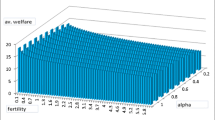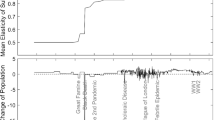Abstract
In this paper, a C-K model with solvable endogenous fertility under the strongly additive utility function is presented. The discrimination conditions of the existence of the nonzero steady states are given. Under a kind of utility function and production function, we prove that these conditions are satisfied and the economy at least has an optimal growth path. The positional relationship of the multiple steady states on the plane is discussed when multiple steady states and multiple growth paths exist. By numerical analysis, the fertility decreases with the per capita capital and per capita consumption increasing and increases with the per capita capital and per capita consumption decreasing on the economic growth path are obtained.
Similar content being viewed by others
References
Ehrlich, I., Lui, F., The problem of population and growth: A review of the literature from Malthus to contemporary models of endogenous population and endogenous growth, Journal of Economic Dynamics and Control, 1997, 21:205–242.
Theodore, P., Endogenous fertility, multiple growth paths, and economic convergence, Journal of Economic Dynamics and Control, 1995, 19:1489–1510.
Tamura, R., From decay to growth: A demographic transition to economic growth, Journal of Economic Dynamics and Control, 1996, 20:1237–1261.
Galor, O. and Weil, D. W., the gender gap, fertility, and growth, The American Economic Review, 1996, 86(3):374–387.
Becker, G. S., Murphy, K. M., Human capital, fertility, and economic growth, Journal of Political Economy, 1990, 98(5) (Part. 2):S12–37.
Dahan, M. and Tsiddon, D., Demographic transition, income distribution, and economic growth, Journal of Economic Growth, 1998, 3(1):29–52.
Imhoff, I. V., Optimal Economic Growth and Non-stable Population, Springer-Verlag, 1991.
Cai Donghan, A C-K model with solvable endogenous fertility, Journal of Wuhan University (Natural Science Edition (Chinese Edition), 1998, 44(1):29–33.
Cai Donghan, Multiple growth paths, multiple steady states and bifurcation, Acta Mathematica Scientia (Chinese Edition), 1998, 18(3):348–354.
Numerical Calculation Methods, Edited by Wuhan University and Shandong University, People Education Publishing House, 1990.
Author information
Authors and Affiliations
Additional information
Supported by National Natural Science Foundation of China (79970104).
Rights and permissions
About this article
Cite this article
Donghan, C. The C-K model with solvable endogenous fertility. Appl. Math. Chin. Univ. 15, 193–200 (2000). https://doi.org/10.1007/s11766-000-0026-3
Received:
Issue Date:
DOI: https://doi.org/10.1007/s11766-000-0026-3




